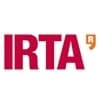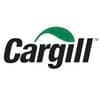Bienestar en becerras: transiciones desde el periodo perinatal hasta el destete
incrementándose en la última década, donde no sólo se invierte en instalaciones, sino en aditamentos que generan un microambiente más amable para el ganado adulto. En la crianza de reemplazos, si bien ha habido un cambio de mentalidad en cuanto a los requerimientos de estas becerras, algunos ganaderos cuyo número va en aumento, apuestan por incrementar las condiciones de confort y bioseguridad.
como una fábrica de producción láctea y que no es del todo cierta, si hay áreas donde se requiere revisar a profundidad las condiciones de vida de estos animales.
2. Libres de incomodidad física y térmica.
3. Libres de dolor, daño y enfermedades.
4. Libres para expresar su comportamiento natural.
5. Libres para expresar su miedo e incomodidad.
recién nacido, representa un costo por mortinato entre 400 y 600 dólares dependiendo de su genética, con la pérdida de la siguiente generación y posibles consecuencias ginecológicas en la madre (De Vries, 2009). El costo por la pérdida de la cría lactante, depende de la inversión que se ha hecho, siendo alimentación, manejo, instalaciones, cama, fármacos y genética los rubros más elementales. Mientras más grande la muerte del reemplazo, mayor impacto económico de la pérdida. Estas inversiones generan un retorno de capital poco evidente para el productor, un ciclo de productividad láctea puede tardar desde 14 a 18 meses de producción láctea en cubrir los gastos de alimentación, labores, fármacos, cama y amortización de mejoras en instalaciones (Van Amburgh, 2017).
ambiente externo al uterino en las primeras horas post-parto. La muerte perinatal está relacionada con problemas cardiovasculares, respiratorios, termoregulatorios y metabólicos, por lo que un becerro adecuadamente asistido conforme a la signología que presenta tiene mejor probabilidad de supervivencia (House, 2015).
adrenalina, y comienza el intercambio gaseoso (Tyler y Ramsey, 1991; Kasari, 1994). Un deficiencia de oxígeno a 10.5% O2 identificado como hipoxia, produce depresión del sistema nervioso central y alteración de los reflejos (Nagg, 2009). Los vasos sanguíneos se contraen y relajan por efecto de la acetilcolina, adrenalina y tiroxina. Esto modifica el tono muscular, lo que permite al recién nacido recibir suficiente flujo sanguíneo y glucosa para tener la fortaleza para erguir la cabeza y sostenerla (Barrier et al., 2012). El volúmen tidal de la becerra recién nacida es de 220 ml por respiración, estableciéndose a las dos semanas de vida en 280 ml (Nagy, 2009).
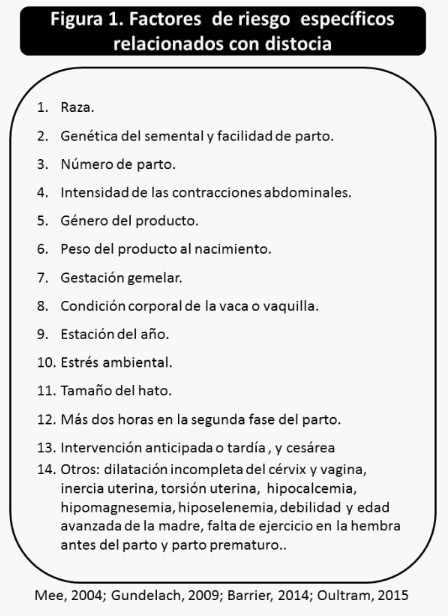
principales factores de riesgo para mortalidad perinatal.
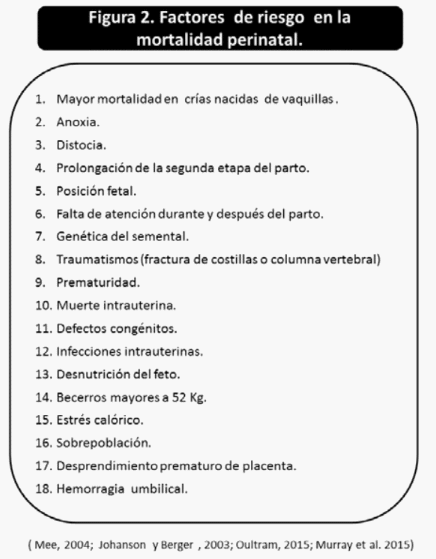
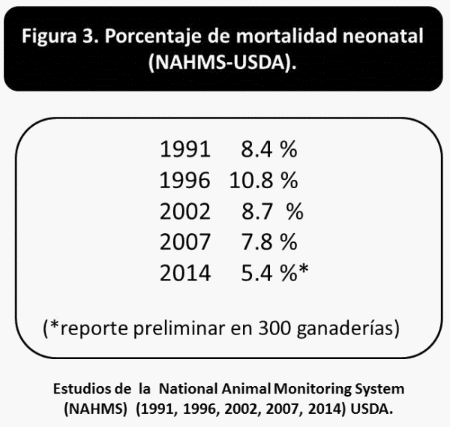
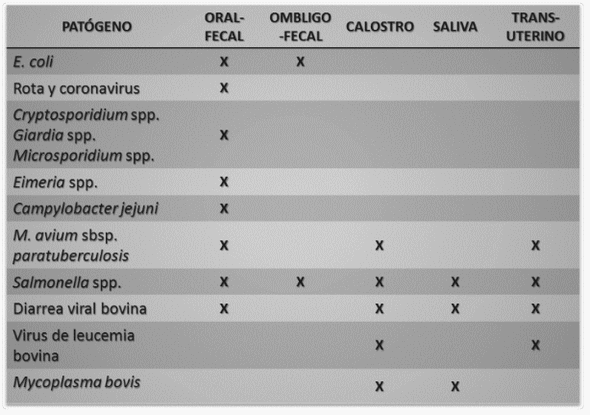
Trueperella pyogenes, y E. coli (Maunsell y Donovan, 2008; Maunsell y Donovan, 2009).
son tuberculosis, coronavirosis, antracosis, brucelosis, pasteurelosis, mainhemiosis y complejo respiratorio bovino (CFSPH, 2005; Virtala et al, 1996).


su lectura o someter a centrifugación. El sistema de refractometría para grados Brix también puede ser utilizado. El punto de corte para 5.5 g/dL de IgG en sangre es de 8.4 % (Deelen et al, 2014). La prueba por precipitación de sulfito de sodio (0.1 ml de suero en 1.9 ml de solución al 14, 16 y 18%, se homogeniza suavemente y se deja incubando por 1 h temperatura ambiente). La solución anhidra de Na2SO3 (Sigma-Aldrich), se recomienda que únicamente se use la dilución al 18% (180 g de Na2SO3 en 820 ml de H2O). La prueba de turbidez por sulfato de Zinc no se recomienda como sistema diagnóstico para determinación de inmunoglobulinas (Constable, 2012)(Tabla 3).
mortalidad, menores pesos durante su desarrollo.
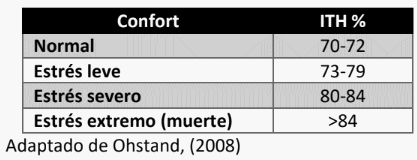
incrementa la progestina durante la última parte de la gestación.
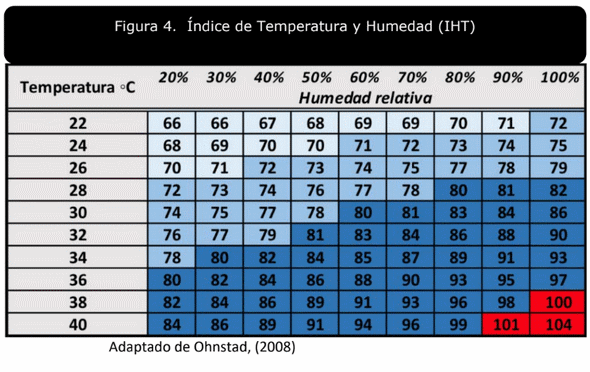
1. Alexander, G., Bennett, J. W., Gemmell, R. T. (1975). Brown adipose tissue in the new-born calf (Bos taurus). The Journal of physiology, 244(1), 223-234.
2. Asakura, H. (2004). Fetal and neonatal thermoregulation. Journal of Nippon Medical School, 71(6), 360-370.
3. Atrian, P., & Shahryar, H. A. (2012). Heat stress in dairy cows (a review). Research in Zoology, 2(4), 31-37.
4. Barrier, A., Mason, C., Dwyer, C., Haskell, M. & Macrae, A. (2013). Stillbirth in dairy calves is influenced independently by dystocia and body shape. The Veterinary Journal 197(2): 220-223.
5. Barrier, A. C., Ruelle, E., Haskell, M. J., & Dwyer, C. M. (2012). Effect of a difficult calving on the vigour of the calf, the onset of maternal behaviour, and some behavioural indicators of pain in the dam. Preventive veterinary medicine, 103(4), 248-256.
6. Beam, A. L., Lombard, J. E., Kopral, C. A., Garber, L. P., Winter, A. L., Hicks, J. A., Schlater, J. L. (2009). Prevalence of failure of passive transfer of immunity in newborn heifer calves and associated management practices on US dairy operations. Journal of Dairy Science 92(8): 3973-3980.
7. Bellomo, R. (2002). Bench-to-bedside review: lactate and the kidney. Critical Care, 6(4), 322.
8. Berglund, B., Steinbock, L., Elvander, M. (2003). Causes of Stillbirth and Time of Death in Swedish Holstein Calves Examined Post Mortem. Acta Veterinaria Scandinavica 44(3): 111-120.
9. Besser, T. E., & Gay, C. C. (1994). The importance of colostrum to the health of the neonatal calf. Veterinary Clinics of North America: Food Animal Practice, 10(1), 107-117.
10. Bickett-Weddle, D., Ramirez, A. (2005). Dairy Biological Risk Management- Key points. Iowa: Iowa State University.
11. Brickell, J. S., McGowan, M. M., Pfeiffer, D. U., Wathes, D. C. (2009). Mortality in Holstein-Friesian calves and replacement heifers, in relation to body weight and IGF-I concentration, on 19 farms in England. animal 3(08): 1175-1182.
12. Bielmann, V., Gillan, J., Perkins, N., Skidmore, A., Godden, S. &Leslie, K. (2010). An evaluation of Brix refractometry instruments for measurement of colostrum quality in dairy cattle. Journal of Dairy Science 93(8): 3713-3721.
13. Bleul, U., & Götz, E. (2013). The effect of lactic acidosis on the generation and compensation of mixed respiratory-metabolic acidosis in neonatal calves. The Veterinary Record, 172(20), 528-528.
14. Calfcare.ca (2015). Veal Farmer from Ontario http://calfcare.ca/articles/is-the-summer-heat- stressing-out-your-calves/. Revisado 19 de febrero de 2018.
15. Collier, R. J., G. E. Dahl, and M. J. VanBaale. 2006. Major advances associated with environmental effects on dairy cattle. J. Dairy Sci. 89:1244–1253.
16. Constable, P. D. (2012). Colostrum Management and how to optimize and monitor transfer of passive immunity-Dairy and Beef. In Australian Cattle Veterinarian's Conference, Hunter Valley NSW.
17. Constable, P. D., Hinchcliff, K. W., Done, S. H., & Grünberg, W. (2016). Veterinary medicine-e-book: a textbook of the diseases of cattle, horses, sheep, pigs and goats. Elsevier Health Sciences.
18.Dahl, G. E., Tao, S., & Laporta, J. (2017). TRIENNIAL LACTATION SYMPOSIUM/BOLFA: Late gestation heat stress of dairy cattle programs dam and daughter milk production. Journal of Animal Science, 95(12), 5701- 5710.
19.DCHA (2016). Dairy Calf & Heifer Association Gold Standards. Chesterfield, Missouri: Dairy Calf & Heifer Association.
20. de la Fuente, R., Luzón, M., Ruiz-Santa-Quiteria, J. A., García, A., Cid, D., Orden, J. A., García, S., Sanz, R. & Gómez-Bautista, M. (1999). Cryptosporidium and concurrent infections with other major enteropathogens in 1 to 30-day-old diarrheic dairy calves in central Spain. Veterinary Parasitology 80(3): 179-185.
21.Deelen, S., Ollivett, T., Haines, D. &Leslie, K. (2014). Evaluation of a Brix refractometer to estimate serum immunoglobulin G concentration in neonatal dairy calves. Journal of Dairy Science 97(6): 3838-3844.
22.Divers, T. J. &Peek, S. (2007). Rebhun's diseases of dairy cattle. Elsevier Health Sciences United States Department of Agriculture (2010). Heifer Calf Health and Management Practices on US Dairy Operations, 2007, Fort Collins: USA.
23.Do Amaral, B. C., Connor, E. E., Tao, S., Hayen, J., Bubolz, J., & Dahl, G. E. (2009). Heat-stress abatement during the dry period: Does cooling improve transition into lactation?. Journal of dairy science, 92(12), 5988- 5999.
24. FAO (2011).Guide to good dairy farming practice. Animal Production and Health Guidelines. In No. 8.Rome, Italy: Food and Animal Organization.
25. Fleenor, W. &Stott, G. (1981). Single radial immunodiffusion analysis for quantitation of colostral immunoglobulin concentration. Journal of Dairy Science 64(5): 740-747.
26.Johanson, J. M. Berger., P. J. (2003). Birth Weight as a Predictor of Calving Ease and Perinatal Mortality in Holstein Cattle. Journal of Dairy Science 86(11): 3745- 3755.
27. Kasari, T. R. (1994). Physiologic mechanisms of adaptation in the fetal calf at birth. Veterinary Clinics of North America: Food Animal Practice, 10(1), 127-136.
28. Kasari, T. R. (1994). Weakness in the newborn calf. Veterinary Clinics of North America: Food Animal Practice, 10(1), 167-180.
29. Key, N., Sneeringer, S., Marquardt, D. (2014). Climate change, heat stress, and US dairy production.
30.Grandin, T. (2015). An Introduction to Implementing and Effective Animal Welfare Program. Improving animal welfare: a practical approach. (2nd Ed.). Ed. Cab.
31.Grove-White, D. (2000). Resuscitation of the newborn calf. In Practice, 22(1), 17-23.
32.Gundelach, Y., Essmeyer, K., Teltscher, M., Hoedemaker, M. (2009). Risk factors for perinatal mortality in dairy cattle: Cow and foetal factors, calving process. Theriogenology 71(6): 901-909.
33.Guo, J. R., Monteiro, A. P. A., Weng, X. S., Ahmed, B. M., Laporta, J., Dahl, G. E. , Bernard, J.K., (2016). Effect of maternal heat stress in late gestation on blood hormones and metabolites of newborn calves. Journal of Dairy Science, 99 (8), 6804-6807.
34. Le Neindre, P., & D'Hour, P. (1989). Effects of a postpartum separation on maternal responses in primiparous and multiparous cows. Animal Behaviour.
35. Lombard, J. et al. (2015), NAHMS Dairy 2014, Dairy Herd Magazine. http://www.dairyherd.com/news/industry/nahms- dairy-2014.
36.Hamersma, E. (2011). Ultrasonographic measurement of abomasal volume in calves after administering 4 liters colostrum through tube feeding. (Ed R. P. V. M. U. University). Utrecht: Utrecht University.
37.Harris, A., & Seckl, J. (2011). Glucocorticoids, prenatal stress and the programming of disease. Hormones and behavior, 59(3), 279-289.
38.Holtgrew-Bohling, K. J. (2015). Bovine Husbandry. In Large Animal Clinical Procedures for Veterinary Technicians, 428-429 St. Louis, Missouri: Elsevier.
39.Homerosky, E. R., Caulkett, N. A., Timsit, E., Pajor, E. A., Kastelic, J. P., & Windeyer, M. C. (2017). Clinical indicators of blood gas disturbances, elevated L-lactate concentration and other abnormal blood parameters in newborn beef calves. The Veterinary Journal, 219, 49- 57.
40.House, J. (2015). The Peripartum Ruminant. In Large Animal Internal Medicine (Ed B. P. Smith). Cap 283. St. Louis, Missouri: Elsevier.
41. Mader, T. L., Davis, M. S., & Brown-Brandl, T. (2006). Environmental factors influencing heat stress in feedlot cattle12. Journal of Animal Science, 84(3), 712-719.
42. Matthews, S. G. (2002). Early programming of the hypothalamo–pituitary–adrenal axis. Trends in Endocrinology & Metabolism, 13(9), 373-380.
43. Maunsell, F.P., Donovan, G.A. (2008). Biosecurity and risk management for dairy replacements. Vet Clin North Am Food Anim Pract. 24(1): 155-190.
44. Maunsell, F.P., Donovan, G.A. (2009). Mycoplasma bovis infection in young calves. Biosecurity and risk management for dairy replacements. Vet. Clin. North. Am. Food Anim. Pract. 25(1): 160-161.
45. McGuirk, S. M. &Collins, M. (2004). Managing the production, storage, and delivery of colostrum. Veterinary Clinics of North America: Food Animal Practice 20(3): 593-603.
46. Mee, J. F. Managing the dairy cow at calving time. Veterinary Clinics: Food Animal Practice 20(3): 521-546.
47. Mee, J. F. (2008). Newborn Dairy Calf Management. Veterinary Clinics of North America: Food Animal Practice 24(1): 1-17.
48. Mee, J., Berry, D. & Cromie, A. (2011). Risk factors for calving assistance and dystocia in pasture-based Holstein–Friesian heifers and cows in Ireland. The Veterinary Journal 187(2): 189-194.
49. Mee, J. F. (2013). Why do so many calves die on modern dairy farms and what can we do about calf welfare in the future? Animals 3(4): 1036-1057.
50. Meijering, A. (1984). Dystocia and stillbirth in cattle; A review of causes, relations and implications. Livestock Science 11(2): 143-177.
51. Mellado, M., Lopez, E., Veliz, F. G., De Santiago, M. A., Macias-Cruz, U., Avendaño-Reyes, L., & Garcia, J. E. (2014). Factors associated with neonatal dairy calf mortality in a hot-arid environment. Livestock Science, 159, 149-155.
52. Monteiro, A. P. A., S. Tao, I. M. T. Thompson, and G. E. Dahl. 2016. In utero heat stress decreases calf survival and performance through the first lactation. J. Dairy Sci. 99:8443–8450.
53. Murray, C. F., Veira, D. M., Nadalin, A. L., Haines, D. M., Jackson, M. L., Pearl, D. L. y Leslie, K. E. (2015). The effect of dystocia on physiological and behavioral characteristics related to vitality and passive transfer of immunoglobulins in newborn Holstein calves. Canadian journal of veterinary research. Revue canadienne de recherche veterinaire 79(2): 109-119.
54. Murray, C. F., & Leslie, K. E. (2013). Newborn calf vitality: Risk factors, characteristics, assessment, resulting outcomes and strategies for improvement. The Veterinary Journal, 198(2), 322-328.
55.Nagy, D. W. (2009). Resuscitation and critical care of neonatal calves. Veterinary Clinics: Food Animal Practice, 25(1), 1-11.
56.OIE (2017). Terrestrial Animal Health Code. Capítulo 7.11. Animal Welfare and Dairy Cattle Production Systems. Consultado febrero 7, 2018. http://www.oie.int/fileadmin/Home/eng/Health_stand ards/tahc/current/chapitre_aw_dairy_cattle.pdf.
57.Ohnstad, I. (2008). Clinical: Heat stress in dairy cows. Livestock, 13(3), 25-28.
58.Oultram, J. W. & Holman, A. N. (2015). Pitfalls in bovine obstetrics and how to avoid them. Livestock (Electronic) 20(1): 20.
59. Reeves, J. T., & Leathers, J. E. (1964). Circulatory changes following birth of the calf and the effect of hypoxia. Circulation Research, 15(4), 343-354.
60. Romano Muñoz, JL., Vázquez-Flores, S. Haubi Segura, CU, Shimada Miyasaka, A. Capítulo 9. Desórdenes metabólicos del rumiante en el libro de Nutrición Animal (2018). 4a Edición. Editor Armando Shimada Miyasaki. Editorial Trillas SA de CV, México. ISBN 978- 607-17-31201. pp 277-306.
61. Rushen, J., De Passillé, A.M., Von Keyserlingk, M.A.G. and Weary, D.M., T. The welfare of Cattle (2008) Springer Science & Business Media. pp 7.
62. Stewart, S., Godden, S., Bey, R., Rapnicki, P., Fetrow, J., Farnsworth, R., Scanlon, M., Arnold, Y., Clow, L. &Mueller, K. (2005). Preventing bacterial contamination and proliferation during the harvest, storage, and feeding of fresh bovine colostrum. Journal of Dairy Science 88(7): 2571-2578.
63. St-Pierre, N. R., Cobanov, B., & Schnitkey, G. (2003). Economic losses from heat stress by US livestock industries1. Journal of dairy science, 86, E52-E77.
64. Tao, S., A. P. A. Monteiro, I. M. Thompson, M. J. Hayen, and G. E. Dahl. 2012. Effect of late-gestation maternal heat stress on growth and immune function of dairy calves. J. Dairy Sci. 95:7128–7136.
65. Terra, R., Reynolds, J. (2015).Ruminant History, Physical Examination, Welfare Assessment, and Records. In Large Animal Internal Medicine(Ed B. Smith). St. Louis, Missouri: Elsevier.
66. Tyler, H., & Ramsey, H. (1991). Hypoxia in neonatal calves: Effect on selected metabolic parameters. Journal of Dairy Science, 74(6), 1957-1962
67. Van Amburgh, M, (2017) Dairy Replacement Heifers: Transitioning from Weaning Through the First Lactation, ADSA Discovery 32 Conferences.
68. Vieira, A. D. P., Guesdon, V., De Passille, A. M., von Keyserlingk, M. A. G., & Weary, D. M. (2008). Behavioural indicators of hunger in dairy calves. Applied Animal Behaviour Science, 109(2), 180- 189.
69. Vasseur, E., Borderas, F., Cue, R. I., Lefebvre, D., Pellerin, D., Rushen, J., Wade, K.M. and De Passillé, A. M. (2010). A survey of dairy calf management practices in Canada that affect animal welfare. Journal of Dairy Science, 93(3), 1307-1316.
70. Vasseur, E., Pellerin, D., de Passille, A. M., Winckler, C., Lensink, B. J., Knierim, U., & Rushen, J. (2012) Assessing the welfare of dairy calves: outcome-based measures of calf health versus input-based measures of the use of risky management practices. Animal Welfare, 21(1), 77-86.
71. Vázquez-Flores, S. (2008).Bioseguridad en crianza de becerras. En Memorias del Curso Avimex de Salud y Productividad, Bovinos de Leche “Crianza y Salud de hato”. Pre-congreso ESGAL. Torreón, Coahuila: Avimex.
72. Vázquez-Flores, S., L Rojas-Lopez, D Maycotte- Cervantes, D de la Torre (2014). Distribution of enteric parasites in Dairy and Beef Cattle in different production stages. A study from 2008 to 2013 in the main cattle states of México. In World Buiatrics Congress (Ed D. Beggs). Cairns, Australia: Saint Leonards : Australian Veterinary Association - New South Wales, July 2014. ISBN 978-0-992546-2-6 (paperback) 978-0-9925465-3-3 (electronic version).
73. Vázquez Flores, S., Consuelo Alexandra Tejas Yáñez, Stephany Barrera Almanza, Rodrigo Alberto Jiménez Moreno, Lucía Karina Cornejo, Ma. del Refugio Amado Flores (2015). Determinación de patógenos gastrointestinales en becerros neonatos Holstein tratados con fermentos de Saccharomyces cerevisiae. In XII Encuentro Participación de la Mujer en la Ciencia. (Ed C. S. Sosa). León, Guanajuato CIO. ISSN 2448-5063.
74. Vázquez Flores, S., Andrea Olamendi Uresti, Dulce María Aguilar López, Luz Elena Díaz Avila, Cecilia Lucio Rodríguez y Carolina Guizar Bravo (2017). Determinación de IgG en suero sanguíneo de machos Holstein alimentados con calostro de vaquillas suplementado con calostro deshidratado. Avances de la Ciencia en México, Capítulo 1: Biología y Ciencias Agropecuarias. Editorial Centro de Investigaciones en Óptica, SC. ISBN 978-607-95228-8-9. Pp 984- 989. http://cio.mx/avance_de_la_ciencia_en_Mexico_ 2017.php
75. Virtala, A., Mechor GD, Gröhn YT, Erb HN, Dubovi EJ (1996). Epidemiologic and pathologic characteristics of respiratory tract disease in dairy heifers during the first three months of life. J Am Vet Med Assoc 208: 2035-2042.
76. Von Keyserlingk, M. A. G., Rushen, J., de Passillé, A. M., & Weary, D. M. (2009). Invited review: The welfare of dairy cattle—Key concepts and the role of science. Journal of Dairy Science, 92(9), 4101-4111.
77.Wallace, R. (2003). Practical and Sensible Dairy Farm Biosecurity. In Proceedings of the 6th Western Dairy Management Conference, 201-206 Reno, Nevada.
78.Walz, P. H., Mullaney, T. P., Render, J. A., Walker, R. D., Mosser, T. & Baker, J. C. (1997). Otitis media in preweaned Holstein dairy calves in Michigan due to Mycoplasma bovis. Journal of Veterinary Diagnostic Investigation
79.West, J. W. (2003). Effects of heat-stress on production in dairy cattle. Journal of dairy science, 86(6), 2131- 2144.

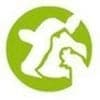


Special Nutrients










